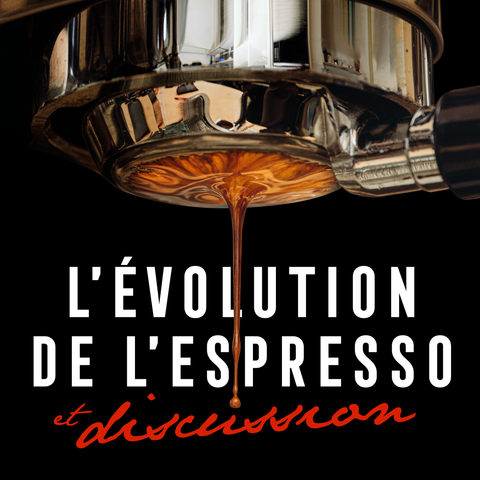
Espresso is currently undergoing an evolution that is completely transforming the way we approach this popular beverage.
The evolution of equipment, the contribution of professionals and scientists who love coffee who bring their knowledge and their rigor to the table transport us completely elsewhere.
Where no man has gone before
The majority of theories propagated by baristas during the famous 3rd wave are therefore reduced to smoke by the scientific method.
And I'm very happy with it.
Because espresso has long been in a world of fine words which masked the preparation of mediocre coffee that does not correspond to the tasting standards of gastronomy.
We were then caught in the shackles of espresso invented by Italian manufacturers who sold it to us as perfection.
And the pattern was repeated for many years.
There were of course some innovations, especially in terms of coffee and milk blends with flat white, or different ratios, but we were always connected to the standards defined several years previously, and the vocabulary used remained that of the Italians.
So if we are currently experiencing a revolution in espresso, thanks to what I told you previously, we are also experiencing it through the contribution of roasters who are increasingly specialized and knowledgeable.
The old roasting method of the old master roaster who roasts by eye, ear and nose may be romantic, but the weakness of the human senses in a process as complex as roasting was overestimated. coffee.
The use of sophisticated roasting equipment, coupled with the availability of quality coffee, leads consumers to experience coffee differently.
Contribution from professionals and sharing of knowledge among consumers thanks to the web and discussion groups;
Contribution of credible scientists like Jonathan Gagné and real studies like this one ;
Appearance of better espresso machines such as double kettles with configurable PID and the Decent espresso which opens the door to a new universe;
Manufacturing of better mills by manufacturers, driven by competition;
Arrival of better coffee roasters, and adjustment of those already in place which adapt with fairer roasts which highlight the coffee;
Arrival of better coffee.
When it comes to coffee, modern means of communication allow producers to isolate batches of better quality and sell them directly to the roaster at a higher price.
It is very beneficial financially for them, because without it, they would have to mix the best batches with generic batches and sell them to the federations in agricultural supply management systems a bit like what we have in Quebec.
We therefore find ourselves with much better coffee on the market than 10-15 years ago.
Add to this the appearance of several new roasting companies fighting for consumers' cups and we obtain fertile ground for the espresso revolution.
I had this revelation last year during a strategic planning work session. The consultant we hired swore by traditional espresso. And as the conversations and tastings piled up, a change took place.
Thanks to the quality of the coffees and the complex tasting profiles, the perception of the beverage has become closer to that of its other favorite beverages, wine and whiskey. And the traditional Italian espressos with their 1:2 ratio and aromatic profile often closer to an ashtray than a good Burgundy suddenly seemed uninteresting to him. And he ended up telling me:
''with your coffees, I prefer to lengthen my espressos to almost 1:3, it's really good and I prolong my tasting experience.''
Note that I was very happy to have converted him, because it was a fairly obvious profession of faith.
We had truly entered the era of espresso transformation.
And the border between traditional espresso and filter coffee is moving to finally ask the question how can we get the maximum pleasure from these coffee beans!
And for about 2 years, it's been a storm in the espresso world. So much so, that as a professional, I have to kick my team's butt to keep up with the wave because consumers have become so knowledgeable, some much more than us.
With the pandemic, brewing coffee seems to have been the ideal vaccine to preserve your mental health!
We have therefore seen the spread of a range of new and different methods, in extraction, but also in the preparation of the coffee mass.
For example in the study mentioned above:
Systematically Improving Espresso: Insights from Mathematical Modeling and Experiment
Scientists came to the conclusion that espresso made with a coarser grind, a smaller dose (15g) extracted at a lower pressure (6 bars) and at a larger ratio (1:2.5 to 1 :3) will give a greater extraction yield.
So if you're using good coffee, wanting to get the most out of it makes sense.
And it's also a way to reduce coffee used and waste, because if you get 22% yield on a 15g dose, you get 3.3g of coffee solids dissolved in water.
And if you make an 18g dose, and you get an 18% yield, you get 3.24g of solid coffee.
3g of coffee for almost the same yield. And the yield may be lower if there is channeling or other problem following preparation.
Aside:
Extraction yield, in short, what is it?
I had a flash that maybe some of you might not understand the definition. Basically, it is the amount (in grams) or percentage of dry coffee, or coffee solids, that was dissolved in the water you prepared the coffee with. This is a very important data that defines the effectiveness of the preparation. As mentioned above, with a 20g dose of coffee in your portafilter, an extraction yield of 20% will allow the transfer of 4g of the initial mass into your cup. This data is usually communicated in % (4g/20g).
We consider a good yield between 18% to 22%. Ideally, we would be as high as possible. With Decent espresso, and ratios of 1:3 to 1:5, we can see users achieving between 25% to 27% extraction!
However, this is in no way an indicator of good taste. An extraction yield of 25% from a robusta will be a sign of effective preparation, but for the taste, we will return.
As the saying goes ''Shit in, shit out''.
And on the other hand, a very high yield is not synonymous with good taste either. The acidity of a coffee can be exacerbated and be unpleasant.
How is extraction yield measured?
You need the right equipment, it's work worthy of a chemistry lab.
It mainly takes a refractometer to measure the refraction of light through the prepared coffee.
We will also note the weight of the coffee at the entrance and at the exit. We will also take note of the extraction time, but this data is not really useful for the calculation.
Example :
18g entered
36g released
Let's assume that the refractometer reading gives us 10%.
This 10% is called TDS (Total dissolved solids).
A TDS of 10%.
We then take the following formula:
Extraction yield (%) = ((Output weight (g) x TDS (%)) / Input weight (g)) x 100
Which gives us :
(36g x 0.10) / 18g = 0.2 so 20%
I could stay on this subject for a long time, but that gives you an idea.
End of aside
It is certain that new approaches to espresso take us elsewhere and move us away from the famous Italian espresso, very short, very powerful, thick, with superabundant crema.
It's crazy how I often perceive conditioning in certain preferences of my clients. Habits, memories, and lifestyle related to beverages are sometimes stubborn and can lead someone to prefer a beverage or food that they consider fundamentally bad. I remain open and kind and I try not to judge even if I don't really understand.
It is for this reason that I particularly appreciate the cold and methodical approach of the scientific method which destroys, with supporting evidence, the claims of good taste of certain coffee manufacturers. No marketing, no emotions, the numbers speak.
On the other hand, taste and preferences can never stand up to the scientific approach. Coffee is a matter of passion and will remain so. Because ultimately, what we are looking for is stimulation of the senses!
So I'm coming back from this long detour to return to this revolution which I find really exciting and stimulating!
We deconstruct the espresso method to connect it more to what is most important, the coffee bean and what allows us to optimize our tasting experience, to enjoy the beverage to the fullest.
The quest for espresso, for the ultimate pleasure of the senses, is a futile quest and that is what makes it so extraordinary. It is also the kind of approach that reassures me in this era of pandemic with a backdrop of global warming and political tension with the USA which wants to re-elect Trump, the dominant China which threatens to take Taiwan and Russia which wants to Ukraine.
It is therefore with great pleasure that I fall into the present moment, in active meditation, choosing our coffee beans, weighing them, grinding them, smelling them, preparing my dose by distributing it with gadgets that look like torture tools and setting my machine with the ultimate goal of the perfect espresso.
Personally, this ritual is very soothing for me, and somewhat contemplative, even if my children find me strange, squatting in front of my counter looking at the bottom of my bottomless filter holder to detect any trace of pipes and film my extractions to send them to my friends.
Zen to the last drop.
Danny Marquis





Comments (2)
Après moult lecture et écoute sur YouTube de personnes qui semble s’y connaître, j’ai expérimenté avec ma machine à expresso que j’ai modifié en installant un rhéostat entre l’alimentation et la pompe ULKA pour moduler le flow. Après expérimentation j’en suis venu à être capable de simuler toutes sortes de profils et techniques d’infusion et aussi avec les conseils de Jonathan Gagné en ajoutant un filtre dans le fond du porte filtre à l’occasion et étirer l’extraction avec un débit très faible simuler un café filtre pas mal du tout. L’expérimentation m’a permis d’infuser de plusieurs façons différentes de bons cafés afin d’en retirer une palette de goût différent que mon palet se plaît à apprendre à apprécier.
Tes articles m’ont ouvert les yeux et je déplore qu’il y ait trop peu de manufacturiers qui nous apportent cette touche de modernité à un prix modique. Je pense à un bouton pour faire des profiles volumétriques, une balance intégrée, etc…
Il faut fabriquer nos équipements ou pousser les manufacturiers à nous offrir des produits qui sortent de la tradition italienne.
Encore et encore
j’en prendrais un à chaque dimanche matin en prenant mon latte ratio 1:3 (lait) fait avec une shot 1:2.3 (18in:42out).
J’adore te lire ça me fait réfléchir à mon tour. Et pour ça merci!